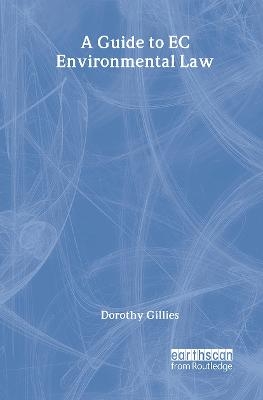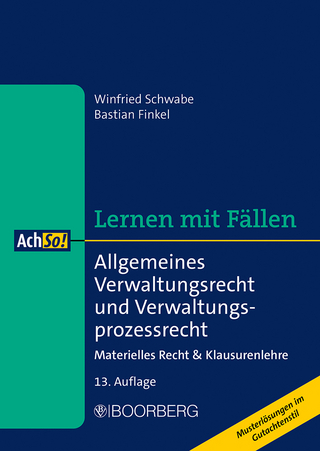
A Guide to EC Environmental Law
Earthscan Ltd (Verlag)
978-1-85383-585-8 (ISBN)
EC law is now a pervasive part of the legislation affecting business, government agencies, the voluntary sector and the individual citizen across the whole of the European Union. This uniquely comprehensive and accessible guide provides a simple and practical explanation of the most important aspects of EC environmental law.
In straightforward terms it introduces the EC and its institutions and explains where EC environmental law and policy can be found. It discusses the main environmental laws relating to air and noise, chemicals and industrial risks, nature conservation, waste and water, and explains how these laws can be used to ensure environmental protection. The book also explains the EC's law-making procedures and discusses the stages at which lobbying can be used to influence the content of future EC environmental laws. Useful case studies and suggestions for further reading for those wishing to research a particular area are also included.
This book will be an invaluable source of reference and practical guidance for lawyers, business, local government, environmental groups and all those needing to understand and use EC law in this area.
Dorothy Gillies is a lawyer and lecturer in law at the University of Glasgow. She has worked in the European Parliament and in the European Commission's Directorate-General XI for Environment, Nuclear Safety and Civil Protection.
Originally published in 1998
Dorothy Gillies is a lawyer and lecturer in law at the University of Glasgow. She has worked in the European Parliament and in the European Commission's Directorate-General XI for Environment, Nuclear Safety and Civil Protection
Acknowledgements
List of Boxes
Acronyms and Abbreviations
About this Book
Part One Background Information
1. The European Community and its Institutions
The Formation and Development of the European Community and the European Union
The EC's Main institutions and Bodies
European Commission
What is the Commission and How is it Organized?
What does the Commission Do?
Council of the European Union
What is the Council and How is it Organized?
What does it Do?
European Parliament
What is the European Parliament and How is it Organized?
What does it Do?
Economic and Social Committee
What is it and What does it Do?
Committee of the Regions
What is it and What does it Do?
European Court of Justice and Court of First Instance
What are they and How are they Organized?
What do they Do?
European Ombudsman
What is it and What does it Do?
European Environment Agency
What is it and What does it Do?
2. Sources of EC environmental Policy and Law
Introduction to EC environmental Policy and Law
Action Programmes for the Environment
Sources of EC Environmental Law
EC Treaty
Directives
Regulations
Decisions
International Agreements
Case Law of the European Court and Court of First Instance
3. Reading EC Environmental Laws
Finding Laws, Proposals for Laws and other Information
Finding Case Law of the European Court and the Court of First Instance
The Structure of EC Laws
Part Two EC Laws for the Protection of the Environment
4. Some general EC Environmental Laws
Introduction
Environmental Impact Assessment
Access to Environmental Information
Integrated Pollution Prevention and Control
Eco-management and Audit Scheme
Eco-labelling
Laws on EL4
Selected Cases on EL4
Law on Access to Environmental Information
Selected Cases on Access to Environmental Information
Law on IPPC
Law on Eco-management and Audit
Law on Eco-labelling
5. Air and Noise
Introduction
Air
Noise
Air Quality Standards
Air Quality in Relation to Specific Substances
General Air Quality
Control on Emissions
Emissions from Industry
The Basic Framework
Detailed Requirements for Certain Industries
Convention on Long-range Transboundary Air Pollution
Integrated Pollution Prevention and Control
Emissions from Vehicles
Emissions of Carbon Dioxide and other Greenhouse Gases
Emissions from Volatile Organic Compounds
Fuel Quality Standards
Noise
Laws relating to Air
Selected Cases Relating to Air
Laws Relating to Noise
6. Chemicals and Industrial Risks
Introduction
Dangerous Chemicals and Substances
Evaluating the Risks of Substances
Marketing and Use
Classification, Packaging and Labelling
Restrictions on Specific Substances
Pesticides
Biocides
Asbestos
Batteries
Ozone-depleting Substances
Genetically Modified Microorganisms (GMOs)
Contained Use of GMOs
Release of GMOs
Major Accident Hazards of Certain Industrial Activities
Transport of Dangerous Goods
By Sea
By Road
By Rail
Export and Import of Dangerous Substances
Transport of Radioactive Substances
Laws Relating to Chemical and Industrial Risks
7. Nature Conservation
Introduction
Birds, Animals, Plants and Habitats within the EC
Protection of Birds
Identification and Protection of Bird Habitats
Identification
Protection of Bird Habitats
Protection of Animal and Plant Species
Identification and Protection of Plant and Animal Habitats
Identification
Protection of Animal and Plant Habitats
Protection of Forests
Restrictions on the Use of Large Drift Nets
International Agreements on the Protection of Species and their Habitats
Convention on the Conservation of Migratory Species of Wild Animals
Convention on the Conservation of European Wildlife and Natural Habitats
Convention on Biological Diversity
Convention on the Protection of the Alps
Convention on the Conservation of Antarctic Marine Living Resources
International Tropical Timber Agreement
Trade in Wild Animals and Plants
Endangered Species
Seal Skins
Fur from Leghold Traps
Laws Relating to Nature Conservation
Selected Cases on Nature Conservation
8. Waste
Introduction
Waste and Hazardous Waste
Waste Incineration
Municipal Waste Incinerators
Hazardous Waste Incinerators
Specific Categories of Waste
Packaging Waste
Waste Oils
PCBs and PCTs
Sewage Sludge
Batteries and Accumulators
Titanium Dioxide
Supervision and Control of Shipments of Waste
Laws Relating to Waste
Selected Cases Relating to Waste
9. Water
Introduction
Quality of Waters used for Particular Purposes
Bathing Water
Fish and Shellfish Waters
Drinking Water
Control of Discharges to Water
Dangerous Substances
Integrated Pollution Prevention and Control
Protection of Groundwater (Aquifers)
Urban Waste Water Treatment
Nitrates from Agricultural Sources
International Agreements in Relation to Water
Convention for the Prevention of Marine Pollution from Land-based Sources (Paris Convention)
Agreement for Cooperation in Dealing with Pollution of the North Sea by Oil and other Harmful Substances (Bonn Agreement)
Convention on Protection of the Marine Environment of the Baltic
Convention for the Protection of the Mediterranean Sea against Pollution
Convention on the Protection and Use of Transboundary Watercourses and International Lakes (Helsinki Convention)
Convention for the Protection of the Rhine against Chemical Pollution
Laws Relating to Water
Selected Cases Relating to Water
Part Three Using EC Law to Protect the Environment
10. Using EC Environmental Laws in the Member States
Introduction
Relying Directly on Directives
The Principles of Direct Effect and Supremacy
What Provisions in an Environmental Directive could be Relied on Directly?
How can Provisions in a Directive be Used to Protect the Environment?
Who can a Directive be Used Against?
Relying on International Environmental Agreements
Sympathetic Interpretation
Selected Cases on Using EC Environmental Laws in the Member States
11. Suing the State for its Failure to Comply with EC Environmental Law
The Conditions which need to be Fulfilled in Suing the state
Conditions 1 and 2 - the Law Infringed was Intended to Give Rights to Individuals and the Content of those Rights is Identifiable on the Basis of the Provisions of the Directive Alone
Condition 3 - the Breach of Community Environmental Law was 'Sufficiently Serious'
Condition 4 - there was a Direct Causal Link between the Breach of Duty by the State and the Loss or Damage Suffered by the Individual
Consequences of Suing the State
Cases Relating to Suing the State
12. What do National Courts have to do to Make Sure that EC Environmental Laws are Applied?
Introduction
What must National Courts do to Allow Individuals to Use their Community Law Rights?
Requests for Preliminary Rulings
Cases on what National Courts have to do to Ensure that EC Environmental Laws are Applied
13. Making a Complaint to the Commission
The Commission's Complaints Procedure
What can a Complaint to the Commission be about?
Who can make a Complaint?
What Information should be in a Complaint?
How to Speed up Processing of a Complaint
What Happens once the Commission Receives a Complaint?
What Happens once a Case has been Referred to the European Court?
What are the Limits of the Complaints Procedure?
14. Sending Petitions to the European Parliament and Getting Help from MEPs
The Petitions Procedure
What can a Petition be about?
Who can Send a Petition to the Parliament?
What Information should be in a Petition?
What Happens once a Petition has been Sent to the Parliament?
How to Speed up the Processing of a Petition
Other Ways to get help from MEPs
15. Making a Complaint to the European Ombudsman
The Ombudsman's Complaints Procedure
What can a Complaint to the Ombudsman be about?
Who can make a Complaint to the Ombudsman?
What Information should be in a Complaint to the Ombudsman?
What happens once a Complaint has been Sent to the Ombudsman?
Part Four Influencing Future
EC Environmental Laws
16. How are EC Laws Made?
Introduction
How do the EC Institutions Make Laws?
The Consultation Procedure
The Current Position
What will Happen to the Consultation Procedure when the Amsterdam Treaty Comes into Force?
The Cooperation Procedure
The Current Position
What will Happen to the Cooperation Procedure when the Amsterdam Treaty Comes into Force?
The CO-decision Procedure
The Current Position
What will Happen to the CO-decision Procedure when the Amsterdam Treaty Comes into Force?
17. How to Influence Future EC Environmental Laws
Introduction
How to Find out what EC Environmental Laws are Planned
Some General Points about Trying to Influence Proposed Environmental Laws
How can Individuals or Environmental Groups Influence the Content of Future EC Environmental Laws?
Stage 1 -A Proposal for a New Law is Prepared
Introduction
A Policy Decision is Taken to Propose a New Law and Policy Objectives are Agreed upon
Can the Commission be 'Encouraged' to Propose a New Environmental Law?
A Proposal is Drafted
A First Draft of the Proposal is Circulated
The Commission Adopts the Draft as its Formal Proposal for a New Law
Stage 2 - The Proposal is Sent to the Council and is Considered by ECOSOC, Committee of the Regions and European Parliament
What does the Council do at this Stage?
What is the Role of ECOSOC and COR at this Stage?
What Happens when the Proposal is Sent to the European Parliament?
The Proposal is Examined in one of Parliament's Committees
A Vote is Taken by the Whole Parliament (the First Reading)
The Second Reading
Stage 3 - The Proposal is Considered by the Committee of Permanent Representatives (COREPER) before Final Adoption by the Council
How can an Environmental Group get its Point Across to the Key People in the Institutions?
Conclusion
18. Where to Find out More
Introduction
Where to Find More Information
European Documentation Centres (EDCs)
Office for Official Publications of the EC (EUR-OP)
Internet
Information from the Community's Institutions and Organizations
European Parliament
Commission, Council and European Environment Agency
Laws Relating to Access to Information from the Institutions
19. The EC's Organization, Useful Contacts and Addresses
Introduction
Environmental Organizations
European Commission
The Directorates and Units of DG XI of the Commission
European Commission Offices in the Member States
Council of the European Union
European Parliament
Information Offices of the European Parliament in Member States
Economic and Social Committee
Committee of the Regions
European Court of Justice and Court of First Instance
European Ombudsman
European Environment Agency
Office for Official Publications of the European Communities
(EUR-OP)
Sales Agents for EC Official Publications
Further Reading
Index
| Verlagsort | London |
|---|---|
| Sprache | englisch |
| Maße | 156 x 234 mm |
| Gewicht | 453 g |
| Themenwelt | Recht / Steuern ► EU / Internationales Recht |
| Recht / Steuern ► Öffentliches Recht ► Allgemeines Verwaltungsrecht | |
| Recht / Steuern ► Öffentliches Recht ► Umweltrecht | |
| Recht / Steuern ► Privatrecht / Bürgerliches Recht ► Sachenrecht | |
| ISBN-10 | 1-85383-585-4 / 1853835854 |
| ISBN-13 | 978-1-85383-585-8 / 9781853835858 |
| Zustand | Neuware |
| Informationen gemäß Produktsicherheitsverordnung (GPSR) | |
| Haben Sie eine Frage zum Produkt? |
aus dem Bereich


